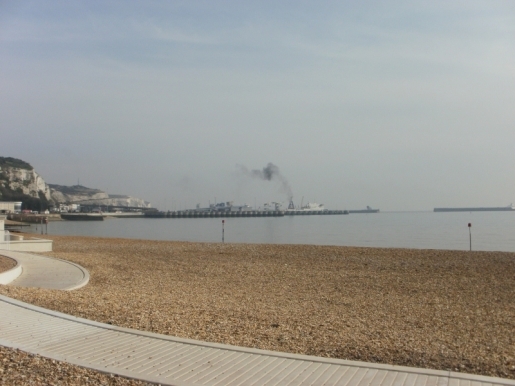Hi Collette, lovely to see you back on the forum.

Howard/Keith: This is a hardy perennial to which I respond at regular intervals! Please concentrate as I shall say zis only once!
Somebody always puts up a photo of a ferry starting her engines up, with a brief gout of black smoke as the first bit of uncombusted fuel passes through each cold engine, always followed by others tut-tutting about uncaring ferries belching black smoke.
The smoke clears within a second or two, as can be seen happening in your photo, but the impression is given that the ferries steam backwards and forwards all day belching (always belching) copious plumes of noxious smoke, poisoning us all and poisoning the planet.
What really happens is that the engines are stopped in port, thereby emitting no pollution, and a second or two of uncombusted fuel cannot be avoided when they are started up again. Just the same as a car or bus or truck. Occasionally an engine may have to be kept running in port to keep the ship alongside the berth in bad weather.
The ship in your photo is the European Seaway. Here is a photo of her leaving port, showing her characteristic emissions whilst underway. There will be no further transient gouts of black smoke until she prepares to leave Calais in two or three hours time.
The fuel used for the main engines is Heavy Fuel Oil (HFO). This used to have a high sulphur content but the North Sea and English Channel were designated as a Sulphur Emission Control Area in 2007 since when the ferries have been required to use low sulphur fuel with a maximum content of 1% sulphur.
This is achieved by taking bunkers which have been refined to 1% sulphur. The other way would have been to take high sulphur content fuel onboard and then filter the emissions as you speculated. This is a complex and expensive procedure and is not used. P&O trialled it with an emission filter on a single generator exhaust on the Pride of Kent some years ago but clearly it was not an economical proposition and their newbuilding employs low sulphur content fuel.
Using low sulphur fuel has greatly reduced sulphur emissions but the ever rising price of fuel has resulted in measures which have had an even greater effect. All of the ferry companies have reduced the speed at which the crossings are made and maintained the schedule by reducing the time spent in port. This small reduction in speed drastically reduces fuel consumption. The three giant DFDS ferries, for example, have four engines but normally run on only two when on passage - all four are required for manoeuvring in port.
Each generation of ferries is more economical on fuel than the preceding generation as advances are made in engine and hull design. For example: the latest ferry to enter service, Spirit of Britain, carries twice the payload of her predecessor, the Pride of Dover, whilst burning the same amount of fuel.
Believe me when I say that every attempt is being made to reduce fuel consumption, it is far and away the single most crucial factor occupying the minds of the ferry companies. Every possible measure is being explored and adopted.
Fuel prices are only going to carry on getting higher, particularly with the situation in the Arab countries (I spent much of my first six months at sea on a tanker running to Marsa el Brega where fighting is now taking place in Libya).
The principal competitor, Eurotunnel, is unaffected as their power supply is from the French nuclear electricity system, with a token input from wind turbines. Their competitive edge is therefore set to improve, even more so if future requirements for HFO to have a 0.1% sulphur content are ratified, resulting in a further dramatic increase in the price of fuel.
 I'm well on the mend now and should be in fine fettle for my coming of age later on this month, 'shush' don't tell anyone
I'm well on the mend now and should be in fine fettle for my coming of age later on this month, 'shush' don't tell anyone 

 Chanters, Drums and Drones Potty Time http://youtu.be/99fMqpjnXYA
Chanters, Drums and Drones Potty Time http://youtu.be/99fMqpjnXYA



